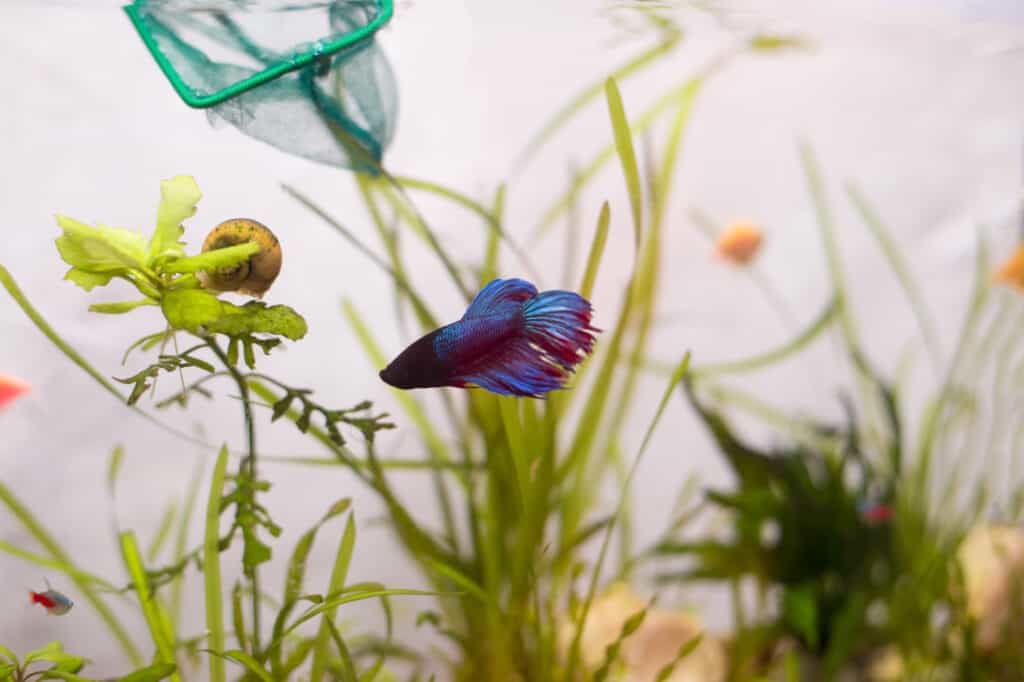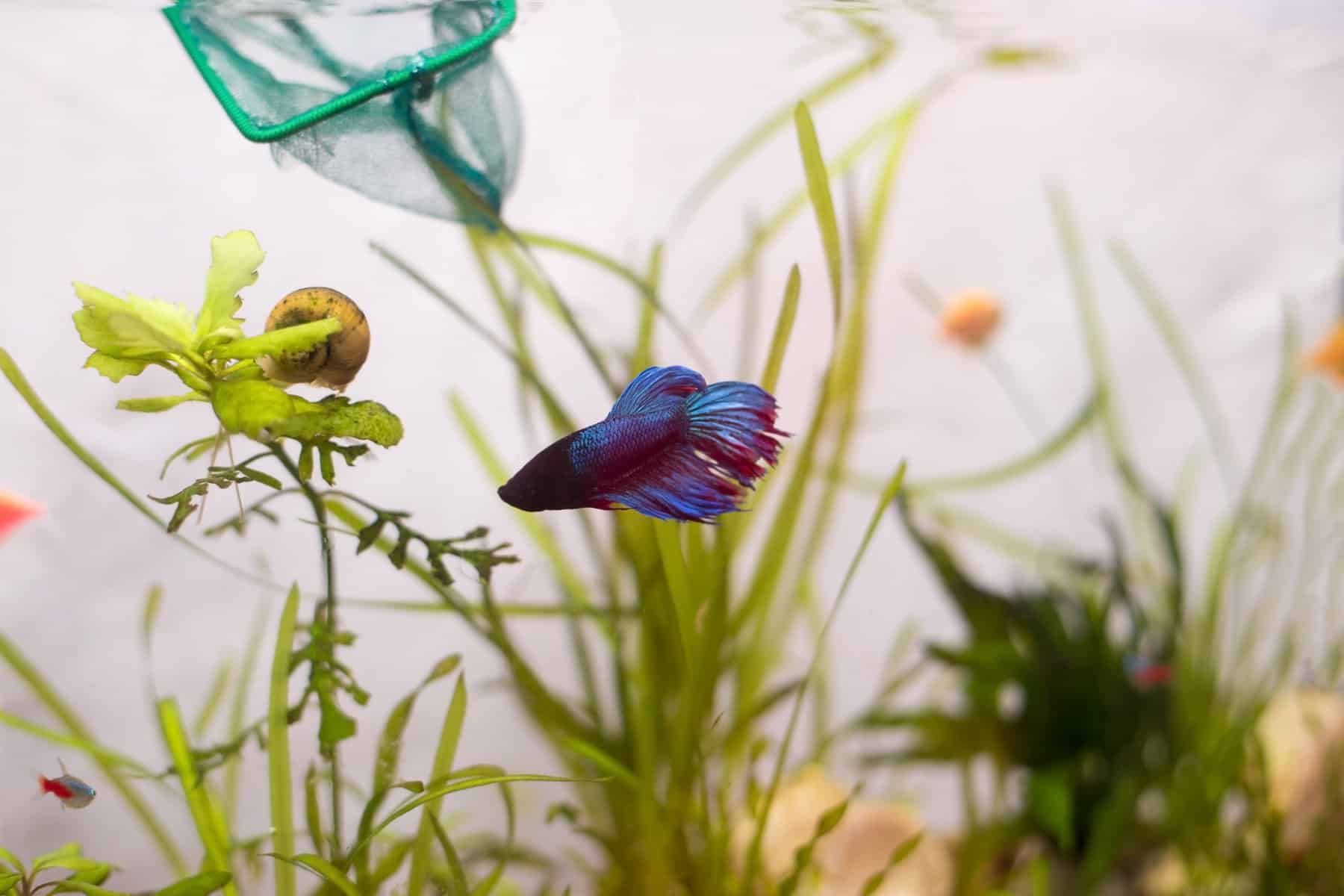Like it or not, partial water changes are a standard part of good aquarium maintenance.
While aquarium filters perform an important cleaning function in the tank, some additional cleaning and water changes are normally essential to keep the aquarium in good health.
A 15-35% partial water change every one or two weeks is the optimum cleaning regime for most betta owners, but to know exactly what’s best for your tank, we’ll need to look at the topic in more detail.
Let’s dive in!
Why Partial Water Changes Are Necessary
Unlike a natural freshwater setting such as a river or lake, a home aquarium is a closed body of water and doesn’t get refreshed by water flow or rain.
With time, certain dissolved substances build up in the water and the tank’s chemistry can be altered. If left unchanged for too long, these substances can build up to dangerous levels.
To maintain a healthy chemistry, regular partial water changes are needed to replace old, tired aquarium water with clean, fresh water from a tap or alternative water source.
Let’s take a closer look at the functions of partial water changes in more detail.
The Functions of Partial Water Changes
Reduces Ammonia and Nitrite Levels
Fish waste, uneaten food in the tank, and decaying plant matter all produce ammonia in the water, which is then converted into nitrites by certain bacteria.
Even small amounts of ammonia can be lethal to fish, so the target amount of ammonia and nitrites in your tank is very simple: none. You always want an ammonia and nitrite count to be at 0 ppm (parts per million) to keep your fish safe and healthy.
Luckily, a good biological filter will do this job for you, by converting the ammonia and nitrites into less harmful nitrates.
But if your filter isn’t working properly and you have an ammonia or nitrite emergency, a large partial water change is one of the fastest ways to correct the problem.
Reduces Nitrate Levels
As we just mentioned, nitrates are less harmful than ammonia and nitrites, but they can still be toxic in large doses.
Scientific studies have found that nitrate levels as low as 44 ppm can affect freshwater shrimp and the most sensitive fish species – and levels above 80 ppm can affect most species of aquarium fish.
Very high nitrate levels can even be lethal to fish and also cause algae blooms which can lead to other problems in the aquarium.
Since nitrates cannot be removed by your filter, performing regular partial water changes is a good way to keep levels in check.
Reduces Phosphate Levels
Like ammonia and nitrites, phosphates are produced in an aquarium by fish waste, uneaten food, and dying plant matter.
And, like nitrates, high levels of phosphates can cause algae blooms in the aquarium which can make the water green, acidic, and depleted in oxygen.
Phosphates don’t harm fish directly, but to keep algae in check, phosphate levels should ideally be kept below 2 ppm. Partial water changes are the most direct way to reduce phosphates in the tank.
Maintains a Stable Water pH
When you add new water from the tap, it begins to chemically interact with everything inside your aquarium.
Many of the biological processes within an aquarium make the water more acidic, and rocks, substrates, and driftwood can also alter the tank’s pH.
Over time, the pH of your tank could be shifted outside of the safe range for your particular fish or aquatic pets, so changing the water regularly is a good way to reset conditions closer to the original water parameters.
How Much and How Often To Make Partial Water Changes
How often you’ll need to change your tank’s water depends on several factors:
Tank Size
Smaller tanks tend to need more regular water changes than larger ones because toxic build-up and changes in the water chemistry tend to happen more quickly in a smaller tank.
The minimum tank size for a betta fish is 5 gallons, but managing water quality in such small aquariums is more difficult.
10 gallons are also popular for bettas, and a 20-gallon tank offers the opportunity to provide your betta with some tank mates too.
Tank Mates
Since they can be quite aggressive, some people prefer to keep betta alone. But there are several small, robust tank mates that can successfully be added to a betta tank too.
Neon tetra, rasboras, corydoras catfish, Amano shrimp, and nerite snails are all popular options.
It can definitely make the tank more fun and interesting to add a few tank mates but remember that each new inhabitant will add their own bio-load of the tank, meaning you’ll have to change the water more often.
Plants
How plants affect your water chemistry and how often you need to change the tank water is a little more complex. That’s because aquatic plants both absorb and produce waste products!
While live plants can reduce nitrate and phosphate levels in the water by absorbing them through their roots, dead plant material breaks down into nitrates and phosphates too.
If your plants are growing strongly and not producing too many dead leaves, then they will tend to have a purifying effect on the water, helping to keep it clean.
Plants that are struggling, on the other hand, will contribute waste products to the tank, thus demanding more frequent cleaning and water changes.
As a General Rule, Weekly or Bi-weekly Water Changes Are Optimal
As we’ve outlined, how much and how often you’ll need to perform partial water changes depends on your tank’s size, inhabitants, and setup.
If you have a 5-gallon betta tank or an aquarium with a high stocking density, it’d be advisable to do small water changes of 15-25% every week.
If you have a single betta in a 10-gallon tank, then you could get away with changing 30-35% of the water every 2 weeks.
Some advanced aquarists with heavily planted tanks can sometimes manage to go longer periods without changing the water, instead utilizing the cleaning power of the plants and manually removing dead leaves to maintain safe conditions.
This method, however, requires regular water testing, luxuriant plant growth, and skillful management, so can’t be recommended for beginners.
Little and Often Is Better Than Too Much At Once!
Your aquarium’s water chemistry and bacterial ecosystem is a delicate thing, and your fish adapt themselves to get used to it.
If it changes suddenly, your fish could become stressed or even shocked and may suffer adverse health problems as a result.
That’s why, in normal circumstances, we wouldn’t recommend water changing more than 40% in any one go.
If you continue to make water changes at regular 1-2 week intervals, harmful substances shouldn’t build up enough to necessitate larger changes anyway.
Emergency Water Changes
In an emergency, if your tank’s filter is broken or you suffer an ammonia spike, you may need to perform an emergency water change to temporarily return the water chemistry to a safer balance.
In this case, remove 50% of the water and replace it with purified, fresh tap water.
When performing larger water changes like this, it’s important to get your replacement water temperature to perfectly match the water in the aquarium to avoid thermal shock in your fish.
How To Perform a Partial Water Change
Gather Your Equipment
You’ll need a bucket, a siphon tube, an old towel, a thermometer, and ideally a gravel cleaner (aquarium hoover) to attach to the end of your siphon tube too.
Start Siphoning
If you have a primer pump on your fish tank hoover then you can just press a button to get the flow started.
If not, you can use gravity to get the flow started or, as a last resort, suck on the tube, being careful not to get any of the water in your mouth (I talk from experience, yuck!)
Remove 20-35% Of the Tank’s Water Into Your Bucket
..mopping up any spillage with an old towel.
Discard the Dirty Water
Tip – Dirty aquarium water can be a great fertilizer for watering house and garden plants!
Fill Your Empty Bucket With Clean Water
Mix it with warm water and check it with a thermometer to make sure it matches the temperature of your aquarium water.
Treat Your New Water With an Aquarium Water Conditioner That Contains a De-chlorinator
..if your tap water contains chlorine.
Chlorine can be lethal to fish, so don’t skip this step!
Be patient and wait until the water purifier has done its job (some people like to do this before removing water in a separate bucket to allow more time for dechlorination).
Pour the Fresh Bucket of Water Very Gently Into Your Fish Tank
Use your hand to deflect the flow and take care not to disturb the fish, plants, and décor.
Repeat filling the tank with buckets until your tank is full. Your partial water change is now complete!
Final Tip: Test Your Tank’s Water Monthly
As part of your routine maintenance, it’s a good idea to test your tank’s water parameters once a month or so.
API’s master test kit reliably tests your aquarium water for pH, ammonia, nitrites, and nitrates – some of the most important components of your tank’s water chemistry.
Getting to know your aquarium’s water chemistry, and how it changes when you clean your tank and change your water, can help you establish the perfect maintenance regime.
Wrap Up
As a general rule, 15-35% partial water changes should be carried out in betta tanks every 1-2 weeks.
Exactly how much and how often depends on the size of your tank, how many fish you have, and your tank setup.
While advanced fishkeepers have found ways to circumvent frequent water changes, for most of us, it’s a regular part of making sure our pet bettas remain happy, healthy, and at their brilliant best.


